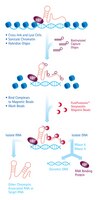Long noncoding RNA GIHCG promotes hepatocellular carcinoma progression through epigenetically regulating miR-200b/a/429.
Sui, CJ; Zhou, YM; Shen, WF; Dai, BH; Lu, JJ; Zhang, MF; Yang, JM
J Mol Med (Berl)
94
1281-1296
2016
Show Abstract
Long noncoding RNAs (lncRNAs) have been reported to play pivotal roles in a variety of cancers. However, lncRNAs involved in hepatocellular carcinoma (HCC) initiation and progression remain largely unclear. In this study, we identified an lncRNA gradually increased during hepatocarcinogenesis (lncRNA-GIHCG) using publicly available microarray data. Our results further revealed that GIHCG is upregulated in HCC tissues in comparison with adjacent non-tumor tissues. High GIHCG expression is correlated with large tumor size, microvascular invasion, advanced BCLC stage, and poor survival of HCC patients. Functional experiments showed that GIHCG promotes HCC cells proliferation, migration, and invasion in vitro, and promotes xenografts growth and metastasis in vivo. Mechanistically, we demonstrated that GIHCG physically associates with EZH2 and the promoter of miR-200b/a/429, recruits EZH2 and DNMT1 to the miR-200b/a/429 promoter regions, upregulates histone H3K27 trimethylation and DNA methylation levels on the miR-200b/a/429 promoter, and dramatically silences miR-200b/a/429 expression. Furthermore, the biological functions of GIHCG on HCC are dependent on the silencing of miR-200b/a/429. Collectively, our results demonstrated the roles and functional mechanisms of GIHCG in HCC, and indicated GIHCG may act as a prognostic biomarker and potential therapeutic target for HCC. KEY MESSAGE: lncRNA-GIHCG is upregulated in HCC and associated with poor survival of patients. GIHCG significantly promotes tumor growth and metastasis of HCC. GIHCG physically associates with EZH2. GIHCG upregulates H3K27me3 and DNA methylation levels on the miR-200b/a/429 promoter. GIHCG epigenetically silences miR-200b/a/429 expression. | 27380494
 |
Long noncoding RNA glypican 3 (GPC3) antisense transcript 1 promotes hepatocellular carcinoma progression via epigenetically activating GPC3.
Zhu, XT; Yuan, JH; Zhu, TT; Li, YY; Cheng, XY
FEBS J
283
3739-3754
2016
Show Abstract
Long noncoding RNA (lncRNA) have critical roles in various pathophysiological processes, and are frequently dysregulated in many diseases, particularly in cancer. The lncRNA glypican 3 antisense transcript 1 (GPC3-AS1) has been reported to be a potential biomarker for hepatocellular carcinoma (HCC) screening. However, the exact biological functions of GPC3-AS1 in HCC, and its roles and regulation mechanisms regarding GPC3 are still unknown. In this study, we observed a significant upregulation of GPC3-AS1 in HCC. Increased expression of GPC3-AS1 was associated with α-fetoprotein, tumor size, microvascular invasion, encapsulation, Barcelona Clinic Liver Cancer stage, and worse prognosis of HCC patients. Furthermore, we found that GPC3-AS1 physically associated with P300/CBP-associated factor and recruited it to the GPC3 gene body region, consequently inducing an increase in euchromatic histone marks and activating GPC3 transcription. GPC3-AS1 expression was strongly correlated with GPC3 in HCC tissues. Gain-of-function and loss-of-function analyses showed that GPC3-AS1 overexpression enhanced HCC cell proliferation and migration in vitro and xenograft tumor growth in vivo. GPC3-AS1 knockdown inhibited HCC cell proliferation and migration. Moreover, the effects of GPC3-AS1 on HCC cell proliferation and migration were dependent on the upregulation of GPC3. Collectively, our studies indicate that GPC3-AS1 significantly promotes HCC progression via epigenetically activating GPC3, and identifies GPC3-AS1 as a potential therapeutic target for HCC. | 27573079
 |
Long Noncoding RNA lncCAMTA1 Promotes Proliferation and Cancer Stem Cell-Like Properties of Liver Cancer by Inhibiting CAMTA1.
Ding, LJ; Li, Y; Wang, SD; Wang, XS; Fang, F; Wang, WY; Lv, P; Zhao, DH; Wei, F; Qi, L
Int J Mol Sci
17
0
2016
Show Abstract
Hepatocellular carcinoma (HCC) is the most common subtype of liver malignancy, and it is characterized by poor prognosis because of cancer stem cell (CSC)-mediated high postsurgical recurrence rates. Thus, targeting CSCs, or HCC cells with CSC-like properties, is an effective strategy for HCC therapy. Here, using long noncoding RNA (lncRNA) microarray analysis, we identified a novel lncRNA termed lncCAMTA1 that is increased in both liver CSCs and HCC. High lncCAMTA1 expression in HCC indicates poor clinical outcome. In vitro and in vivo functional experiments showed that overexpression of lncCAMTA1 promotes HCC cell proliferation, CSC-like properties, and tumorigenesis. Conversely, depletion of lncCAMTA1 inhibits HCC cell proliferation, CSC-like properties, and tumorigenesis. Mechanistically, we demonstrated that lncCAMTA1 physically associates with the calmodulin binding transcription activator 1 (CAMTA1) promoter, induces a repressive chromatin structure, and inhibits CAMTA1 transcription. Furthermore, CAMTA1 is required for the effects of lncCAMTA1 on HCC cell proliferation and CSC-like properties, and the expression of lncCAMTA1 and CAMTA1 is significantly negatively correlated in HCC tissues. Collectively, our study revealed the important roles and underlying molecular mechanisms of lncCAMTA1 on HCC, and suggested that lncCAMTA1 could be an effective prognostic factor and a potential therapeutic target for HCC. | 27669232
 |













